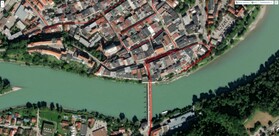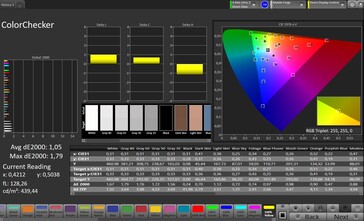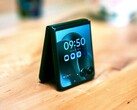Verdict on the Motorola Razr Ultra
If you want a flip smartphone, then you'll have to make compromises—this has been said for a long time. And the new Razr Ultra (also known as Razr 60 Ultra) hasn't quite been able to end this era entirely. It does, thankfully, feature a larger battery that enables runtimes on par with other top-of-the-range devices as well as a fully-fledged high-end processor.
On the other hand, its cameras can't quite keep up when it comes to their zoom capabilities and quality, users will have to contend with high waste heat at times which may even lead to the phone overheating, it only comes with a USB-2.0 connection, and a mediocre update promise is a real issue in this price class.
At the same time, the Razr Ultra is a super stylish smartphone with great surface materials and even better protection against falls or dust. It charges faster, and its RAM has grown in size. In turn, however, you'll have to part with $300 more if you buy this year's model.
All-in-all, the Razr Ultra shows great improvements over its predecessor and further minimizes the gap to conventional high-end phones. That being said, you'll still have to accept a few weaknesses in return for its cool concept.
Pros
Cons
Price and availability
Table of Contents
- Verdict on the Motorola Razr Ultra
- Specifications
- Case and connectivity – Different materials
- Communication and operation – The world phone with WiFi 7
- Software and sustainability – Only 4 years of updates
- Cameras – Not quite high-end level
- Display – Even bigger and brighter
- Performance, emissions and battery life – Sometimes too much power
- Notebookcheck total rating
- Possible alternatives compared
Specifications
Case and connectivity – Different materials
Visually, the Motorola Razr Ultra doesn't differ much from its predecessor, the Razr+ (2024), and its footprint has only changed minimally, too. However, the Razr Ultra weighs 10 grams more, which is likely due to its more powerful battery.
The Razr Ultra is available in four different Pantone colors with different materials. On the model called Scarab, its back is covered by Alacantra, and Mountain Trail uses a type of wood. Cabaret is a vivid pink tone with a satin finish, and Rio Red is a brownish wine-red featuring faux leather.
Its hinge can be opened somewhat easily with one hand, while still holding the phone firmly in every position.
The phone's outer display is protected by Corning Gorilla Glass Ceramic, which is said to offer even better protection against falls. It's only water and dust-proof according to IP48, so not completely dust-tight.
It continues to come with 512 GB of storage, while its RAM has grown to 16 GB. It's annoying that the device still only features a USB 2.0 connection.
Communication and operation – The world phone with WiFi 7
WiFi 7 is on board again and this time, Motorola has increased its speed, achieving well over 1,700 MBit/s in the receiving direction—although we are currently unable to test its fastest mode using our Asus AXE11000 reference router.
Users can use a SIM card and an eSIM, meaning dual-SIM operation is supported. The Razr Ultra is a world phone that supports a wide range of 4G and 5G frequencies.
Both the inner and outer touchscreens can be operated very reliably and both respond super quickly to inputs.
A fingerprint sensor is integrated into the side of its standby button, so it can be used when the phone is closed or open. It unlocks the phone in no time after a print has been saved and boasts very good recognition rates. You can also unlock the device using facial recognition, which works similarly quickly and easily on both sides of the phone.
| Networking | |
| Motorola Razr 60 Ultra | |
| iperf3 transmit AXE11000 6GHz | |
| iperf3 receive AXE11000 6GHz | |
| Motorola Razr 50 Ultra | |
| iperf3 transmit AXE11000 6GHz | |
| iperf3 receive AXE11000 6GHz | |
| Xiaomi Mix Flip | |
| iperf3 transmit AXE11000 | |
| iperf3 receive AXE11000 | |
| Samsung Galaxy Z Flip6 5G | |
| iperf3 transmit AXE11000 | |
| iperf3 receive AXE11000 | |
| iperf3 transmit AXE11000 6GHz | |
| iperf3 receive AXE11000 6GHz | |
| Nubia Flip 5G | |
| iperf3 transmit AXE11000 | |
| iperf3 receive AXE11000 | |
| iperf3 transmit AXE11000 6GHz | |
| iperf3 receive AXE11000 6GHz | |
| Average Wi-Fi 7 | |
| iperf3 transmit AXE11000 | |
| iperf3 receive AXE11000 | |
| iperf3 transmit AXE11000 6GHz | |
| iperf3 receive AXE11000 6GHz | |
| Average of class Smartphone | |
| iperf3 transmit AXE11000 | |
| iperf3 receive AXE11000 | |
| iperf3 transmit AXE11000 6GHz | |
| iperf3 receive AXE11000 6GHz | |
Software and sustainability – Only 4 years of updates
The phone's software is based on Android 15. Motorola has changed very little and outsources lots of additional functions to its own apps.
It's set to receive security updates every two months until 2029, so for almost 4 years. This is a rather average update promise for such an expensive phone.
Its packaging is printed with soy ink and uses no plastic.
Cameras – Not quite high-end level
Motorola has installed three 50-megapixel cameras into the Razr Ultra. The advantage of this concept is that you can also take selfies with its main camera or photograph large groups of friends using the wide-angle lens. The external screen means you can always see how your photo is going to turn out. Plus, you can prop it up securely and without the need for a tripod thanks to its folding mechanism.
The device's main camera takes very colorful and sharp photos that show a lot of detail. However, the bokeh looks a little artificial. We noted strange blurs in some areas of the photo of our surroundings, such as the church tower. Its brightness and dynamics are very good in extremely dark environments, and the sharpness of smaller details is similarly impressive.
Users can record video in a maximum of 8K at 30 fps or 4K at 60 fps. We really like the sharpness of the ones we took and the speed of its autofocus.
Its wide-angle lens takes solid and reasonably detailed pictures.
Selfies taken using the inner camera are good, and we also like its HDR calculation with a bright background.
Image comparison
Choose a scene and navigate within the first image. One click changes the position on touchscreens. One click on the zoomed-in image opens the original in a new window. The first image shows the scaled photograph of the test device.
Main camera plantMain camera surroundingsMain camera low lightWide-angle camera

Display – Even bigger and brighter
The smartphone's inner display has grown slightly to 7 inches, as it now features slimmer bezels. It has a higher resolution as well as a higher brightness compared to its predecessor.
Due to the installed AMOLED technology, you unfortunately can't get around PWM flickering at low brightness levels. However, we measured quite a high frequency of 707 Hz, so sensitive users may still be able to use the screen as well.
Colors are reproduced very accurately by the display as long as you select the mode "Natural".
No changes have been made to its outer screen compared to the Razr+ (2024).
| |||||||||||||||||||||||||
Brightness Distribution: 93 %
Center on Battery: 1379 cd/m²
Contrast: ∞:1 (Black: 0 cd/m²)
ΔE Color 1.05 | 0.5-29.43 Ø4.83
ΔE Greyscale 1.4 | 0.09-98 Ø5.1
99.8% sRGB (Calman 2D)
Gamma: 2.124
| Motorola Razr 60 Ultra AMOLED, 2992x1224, 7" | Motorola Razr 50 Ultra P-OLED, 2640x1080, 6.9" | Xiaomi Mix Flip AMOLED, 2912x1224, 6.9" | Samsung Galaxy Z Flip6 5G Dynamic AMOLED 2X, 2640x1080, 6.7" | Nubia Flip 5G OLED, 2790x1188, 6.9" | |
|---|---|---|---|---|---|
| Screen | -8% | -90% | -65% | 7% | |
| Brightness middle | 1379 | 1099 -20% | 949 -31% | 1210 -12% | 1164 -16% |
| Brightness | 1393 | 1087 -22% | 949 -32% | 1221 -12% | 1172 -16% |
| Brightness Distribution | 93 | 95 2% | 98 5% | 98 5% | 97 4% |
| Black Level * | |||||
| Colorchecker dE 2000 * | 1.05 | 1.04 1% | 2.1 -100% | 3.1 -195% | 0.7 33% |
| Colorchecker dE 2000 max. * | 1.79 | 2.36 -32% | 5.6 -213% | 4.2 -135% | 1.5 16% |
| Greyscale dE 2000 * | 1.4 | 1.1 21% | 3.8 -171% | 2 -43% | 1.1 21% |
| Gamma | 2.124 104% | 2.199 100% | 2.25 98% | 2.05 107% | 2.2 100% |
| CCT | 6362 102% | 6418 101% | 6826 95% | 6666 98% | 6482 100% |
* ... smaller is better
Screen Flickering / PWM (Pulse-Width Modulation)
| Screen flickering / PWM detected | 707 Hz Amplitude: 44 % | ||
The display backlight flickers at 707 Hz (worst case, e.g., utilizing PWM) . The frequency of 707 Hz is quite high, so most users sensitive to PWM should not notice any flickering. In comparison: 53 % of all tested devices do not use PWM to dim the display. If PWM was detected, an average of 8350 (minimum: 5 - maximum: 343500) Hz was measured. | |||
Measurement series with fixed zoom level and different brightness settings (The amplitude curve at minimum brightness looks flat, but this is due to the scaling. The info box shows the enlarged version of the amplitude at minimum brightness).
Display Response Times
| ↔ Response Time Black to White | ||
|---|---|---|
| 2 ms ... rise ↗ and fall ↘ combined | ↗ 0.7 ms rise | |
| ↘ 1.3 ms fall | ||
| The screen shows very fast response rates in our tests and should be very well suited for fast-paced gaming. In comparison, all tested devices range from 0.1 (minimum) to 240 (maximum) ms. » 9 % of all devices are better. This means that the measured response time is better than the average of all tested devices (20.5 ms). | ||
| ↔ Response Time 50% Grey to 80% Grey | ||
| 2.4 ms ... rise ↗ and fall ↘ combined | ↗ 0.9 ms rise | |
| ↘ 1.5 ms fall | ||
| The screen shows very fast response rates in our tests and should be very well suited for fast-paced gaming. In comparison, all tested devices range from 0.165 (minimum) to 636 (maximum) ms. » 9 % of all devices are better. This means that the measured response time is better than the average of all tested devices (32.1 ms). | ||
Performance, emissions and battery life – Sometimes too much power
The Razr Ultra has finally been given the maximum power in the shape of a Snapdragon 8 Elite from Qualcomm, while its predecessor had to make do with the slightly slimmed-down Snapdragon 8s Gen 3. As a result, the Razr Ultra no longer has to trail behind the Galaxy Z Flip from Samsung and is currently the best out of all the flip phones when it comes to performance.
That being said, this comes at a price: Its slim case heats up considerably; we noted over 60°C during our test. Every now and then, the phone even overheated and cut our benchmarks short.
The sound of its speakers, which are supported by the earpiece, is pretty decent and even features deep mids. You can use USB-C or Bluetooth to connect external audio devices. The latter supports quite a lot of codecs, so you can connect your device fairly securely.
Thanks to its powerful 4,700 mAh battery, the Razr Ultra runs for longer than almost any other flip phone: You can expect to surf the web for up to 15:22 hours without needing to reach for a charger. This should be enough for 2 days of normal use. Plus, the phone now charges quicker: it supports up to 68 watts wired and 30 watts wirelessly.
| Geekbench AI | |
| Quantized TensorFlow NNAPI 1.4 | |
| Average of class Smartphone (548 - 4549, n=9, last 2 years) | |
| Motorola Razr 60 Ultra | |
| Average Qualcomm Snapdragon 8 Elite (n=1) | |
| Single Precision TensorFlow NNAPI 1.4 | |
| Average of class Smartphone (231 - 1131, n=9, last 2 years) | |
| Motorola Razr 60 Ultra | |
| Average Qualcomm Snapdragon 8 Elite (n=1) | |
| Half Precision TensorFlow NNAPI 1.4 | |
| Average of class Smartphone (231 - 4555, n=9, last 2 years) | |
| Motorola Razr 60 Ultra | |
| Average Qualcomm Snapdragon 8 Elite (n=1) | |
| Motorola Razr 60 Ultra | Motorola Razr 50 Ultra | Xiaomi Mix Flip | Samsung Galaxy Z Flip6 5G | Nubia Flip 5G | Average 512 GB UFS 4.0 Flash | Average of class Smartphone | |
|---|---|---|---|---|---|---|---|
| AndroBench 3-5 | 15% | 25% | -3% | -45% | 14% | -25% | |
| Sequential Read 256KB | 3504.7 | 4012 14% | 4063.4 16% | 3930.68 12% | 967.4 -72% | 3679 ? 5% | 2144 ? -39% |
| Sequential Write 256KB | 3450.9 | 3512 2% | 3332.67 -3% | 2603.84 -25% | 766.69 -78% | 3102 ? -10% | 1737 ? -50% |
| Random Read 4KB | 308.6 | 340 10% | 367.24 19% | 445.5 44% | 263.87 -14% | 382 ? 24% | 293 ? -5% |
| Random Write 4KB | 347 | 457 32% | 587.21 69% | 202.97 -42% | 295.55 -15% | 469 ? 35% | 334 ? -4% |
(-) The maximum temperature on the upper side is 60.8 °C / 141 F, compared to the average of 35.1 °C / 95 F, ranging from 21.9 to 63.7 °C for the class Smartphone.
(-) The bottom heats up to a maximum of 53.5 °C / 128 F, compared to the average of 34.1 °C / 93 F
(+) In idle usage, the average temperature for the upper side is 25.1 °C / 77 F, compared to the device average of 32.8 °C / 91 F.
3DMark Steel Nomad stress test
| 3DMark - Solar Bay Stress Test Stability | |
| Motorola Razr 60 Ultra | |
| Xiaomi Mix Flip | |
| Samsung Galaxy Z Flip6 5G | |
| Motorola Razr 50 Ultra | |
Motorola Razr 60 Ultra audio analysis
(+) | speakers can play relatively loud (83.1 dB)
Bass 100 - 315 Hz
(-) | nearly no bass - on average 17.6% lower than median
(±) | linearity of bass is average (12.6% delta to prev. frequency)
Mids 400 - 2000 Hz
(+) | balanced mids - only 4.5% away from median
(+) | mids are linear (6.7% delta to prev. frequency)
Highs 2 - 16 kHz
(±) | higher highs - on average 5% higher than median
(±) | linearity of highs is average (9.9% delta to prev. frequency)
Overall 100 - 16.000 Hz
(±) | linearity of overall sound is average (19% difference to median)
Compared to same class
» 22% of all tested devices in this class were better, 9% similar, 69% worse
» The best had a delta of 12%, average was 36%, worst was 134%
Compared to all devices tested
» 43% of all tested devices were better, 8% similar, 50% worse
» The best had a delta of 4%, average was 24%, worst was 134%
Samsung Galaxy Z Flip6 5G audio analysis
(+) | speakers can play relatively loud (90.8 dB)
Bass 100 - 315 Hz
(-) | nearly no bass - on average 24.7% lower than median
(±) | linearity of bass is average (7.5% delta to prev. frequency)
Mids 400 - 2000 Hz
(±) | reduced mids - on average 5.3% lower than median
(+) | mids are linear (5.3% delta to prev. frequency)
Highs 2 - 16 kHz
(+) | balanced highs - only 4.2% away from median
(+) | highs are linear (3.5% delta to prev. frequency)
Overall 100 - 16.000 Hz
(±) | linearity of overall sound is average (17.4% difference to median)
Compared to same class
» 11% of all tested devices in this class were better, 7% similar, 82% worse
» The best had a delta of 12%, average was 36%, worst was 134%
Compared to all devices tested
» 31% of all tested devices were better, 8% similar, 61% worse
» The best had a delta of 4%, average was 24%, worst was 134%
| Off / Standby | |
| Idle | |
| Load |
|
Key:
min: | |
| Motorola Razr 60 Ultra 4700 mAh | Motorola Razr 50 Ultra 4000 mAh | Xiaomi Mix Flip 4780 mAh | Samsung Galaxy Z Flip6 5G 4000 mAh | Average Qualcomm Snapdragon 8 Elite | Average of class Smartphone | |
|---|---|---|---|---|---|---|
| Power Consumption | -18% | 6% | 5% | -47% | -26% | |
| Idle Minimum * | 0.6 | 0.7 -17% | 0.5 17% | 0.51 15% | 1.039 ? -73% | 0.869 ? -45% |
| Idle Average * | 0.9 | 1.1 -22% | 0.92 -2% | 1.18 -31% | 1.599 ? -78% | 1.427 ? -59% |
| Idle Maximum * | 1.4 | 1.5 -7% | 1.1 21% | 1.21 14% | 1.83 ? -31% | 1.588 ? -13% |
| Load Average * | 6.2 | 8.5 -37% | 7.66 -24% | 6.23 -0% | 8.86 ? -43% | 7.16 ? -15% |
| Load Maximum * | 11.3 | 12 -6% | 9.03 20% | 8.01 29% | 12.5 ? -11% | 10.8 ? 4% |
* ... smaller is better
Power consumption: Geekbench (150 cd/m²)
Power consumption: GFXbench (150 cd/m²)
| Motorola Razr 60 Ultra 4700 mAh | Motorola Razr 50 Ultra 4000 mAh | Xiaomi Mix Flip 4780 mAh | Samsung Galaxy Z Flip6 5G 4000 mAh | Nubia Flip 5G 4310 mAh | |
|---|---|---|---|---|---|
| Battery Runtime | -14% | -3% | 1% | 3% | |
| Reader / Idle | 1788 | 1526 -15% | 1995 12% | ||
| H.264 | 1172 | 1022 -13% | 1143 -2% | ||
| WiFi v1.3 | 922 | 726 -21% | 893 -3% | 929 1% | 951 3% |
| Load | 298 | 274 -8% | 246 -17% |
Notebookcheck total rating

The Razr Ultra is stylish and has been improved in many ways under the hood.
If you want an unconventional phone with plenty of power, then this is the right choice for you.
Motorola Razr 60 Ultra
- 05/27/2025 v8
Florian Schmitt
Possible alternatives compared
Image | Model / Review | Price | Weight | Drive | Display |
|---|---|---|---|---|---|
| Motorola Razr 60 Ultra Qualcomm Snapdragon 8 Elite ⎘ Qualcomm Adreno 830 ⎘ 16 GB Memory, 512 GB | Amazon: $1,299.99 List Price: 1299€ | 199 g | 512 GB UFS 4.0 Flash | 7.00" 2992x1224 462 PPI AMOLED | |
| Motorola Razr 50 Ultra Qualcomm Snapdragon 8s Gen 3 ⎘ Qualcomm Adreno 735 ⎘ 12 GB Memory, 512 GB | Amazon: 1. $8.60 Zeking (2 Set for Motorola R... 2. $5.99 10FT USB C Cable Fast Chargi... 3. $15.99 DIACUBE [3+3Pack] For Motoro... List Price: 1200€ | 189 g | 512 GB UFS 4.0 Flash | 6.90" 2640x1080 413 PPI P-OLED | |
| Xiaomi Mix Flip Qualcomm Snapdragon 8 Gen 3 ⎘ Qualcomm Adreno 750 ⎘ 12 GB Memory, 256 GB | Amazon: 1. $368.00 JayTong Foldable LCD Replace... 2. $8.99 QWFORQW [2+2 Pack for Xiaomi... 3. $6.99 QWFORQW 2 Pack Camera Lens P... List Price: 1299€ | 190 g | 256 GB UFS 4.0 Flash | 6.86" 2912x1224 460 PPI AMOLED | |
| Samsung Galaxy Z Flip6 5G Qualcomm Snapdragon 8 Gen 3 for Galaxy ⎘ Qualcomm Adreno 750 ⎘ 12 GB Memory, 512 GB | Amazon: List Price: 1319€ | 187 g | 512 GB UFS 4.0 Flash | 6.70" 2640x1080 426 PPI Dynamic AMOLED 2X | |
| Nubia Flip 5G Qualcomm Snapdragon 7 Gen 1 ⎘ Qualcomm Adreno 644 ⎘ 8 GB Memory, 256 GB UFS 2.1 | Amazon: 1. $21.83 Lkfyyds for ZTE Nubia Flip 5... 2. $23.98 brotect Screen Protector Com... 3. $3.94 ZXL Grey Flip Wallet Case fo... List Price: 599€ | 214 g | 256 GB UFS 2.2 Flash | 6.90" 2790x1188 439 PPI OLED |
Transparency
The selection of devices to be reviewed is made by our editorial team. The test sample was provided to the author as a loan by the manufacturer or retailer for the purpose of this review. The lender had no influence on this review, nor did the manufacturer receive a copy of this review before publication. There was no obligation to publish this review. We never accept compensation or payment in return for our reviews. As an independent media company, Notebookcheck is not subjected to the authority of manufacturers, retailers or publishers.
This is how Notebookcheck is testing
Every year, Notebookcheck independently reviews hundreds of laptops and smartphones using standardized procedures to ensure that all results are comparable. We have continuously developed our test methods for around 20 years and set industry standards in the process. In our test labs, high-quality measuring equipment is utilized by experienced technicians and editors. These tests involve a multi-stage validation process. Our complex rating system is based on hundreds of well-founded measurements and benchmarks, which maintains objectivity. Further information on our test methods can be found here.





































 Total Sustainability Score:
Total Sustainability Score: 

















